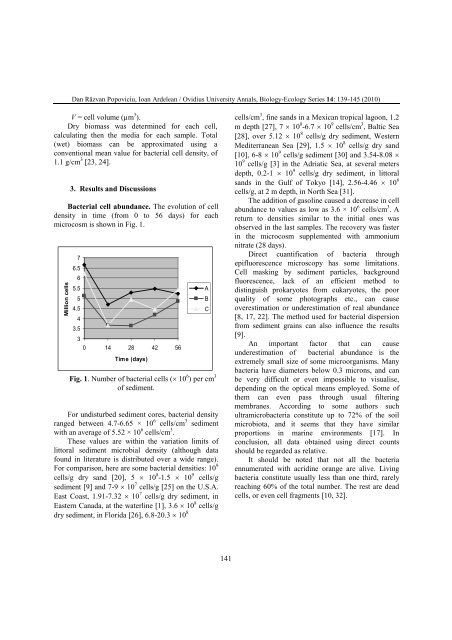VOLUM OMAGIAL - Facultatea de Ştiinţe ale Naturii şi Ştiinţe Agricole
VOLUM OMAGIAL - Facultatea de Ştiinţe ale Naturii şi Ştiinţe Agricole
VOLUM OMAGIAL - Facultatea de Ştiinţe ale Naturii şi Ştiinţe Agricole
You also want an ePaper? Increase the reach of your titles
YUMPU automatically turns print PDFs into web optimized ePapers that Google loves.
Dan Răzvan Popoviciu, Ioan Ar<strong>de</strong>lean / Ovidius University Annals, Biology-Ecology Series 14: 139-145 (2010)<br />
V = cell volume (µm 3 ).<br />
Dry biomass was <strong>de</strong>termined for each cell,<br />
calculating then the media for each sample. Total<br />
(wet) biomass can be approximated using a<br />
conventional mean value for bacterial cell <strong>de</strong>nsity, of<br />
1.1 g/cm 3 [23, 24].<br />
3. Results and Discussions<br />
Bacterial cell abundance. The evolution of cell<br />
<strong>de</strong>nsity in time (from 0 to 56 days) for each<br />
microcosm is shown in Fig. 1.<br />
Million cells<br />
7<br />
6.5<br />
6<br />
5.5<br />
5<br />
4.5<br />
4<br />
3.5<br />
3<br />
0 14 28 42 56<br />
Time (days)<br />
A<br />
B<br />
C<br />
Fig. 1. Number of bacterial cells (× 10 6 ) per cm 3<br />
of sediment.<br />
For undisturbed sediment cores, bacterial <strong>de</strong>nsity<br />
ranged between 4.7-6.65 × 10 6 cells/cm 3 sediment<br />
with an average of 5.52 × 10 6 cells/cm 3 .<br />
These values are within the variation limits of<br />
littoral sediment microbial <strong>de</strong>nsity (although data<br />
found in literature is distributed over a wi<strong>de</strong> range).<br />
For comparison, here are some bacterial <strong>de</strong>nsities: 10 9<br />
cells/g dry sand [20], 5 × 10 8 -1.5 × 10 9 cells/g<br />
sediment [9] and 7-9 × 10 7 cells/g [25] on the U.S.A.<br />
East Coast, 1.91-7.32 × 10 7 cells/g dry sediment, in<br />
Eastern Canada, at the waterline [1], 3.6 × 10 8 cells/g<br />
dry sediment, in Florida [26], 6.8-20.3 × 10 8<br />
141<br />
cells/cm 3 , fine sands in a Mexican tropical lagoon, 1.2<br />
m <strong>de</strong>pth [27], 7 × 10 8 -6.7 × 10 9 cells/cm 3 , Baltic Sea<br />
[28], over 5.12 × 10 8 cells/g dry sediment, Western<br />
Mediterranean Sea [29], 1.5 × 10 8 cells/g dry sand<br />
[10], 6-8 × 10 9 cells/g sediment [30] and 3.54-8.08 ×<br />
10 9 cells/g [3] in the Adriatic Sea, at several meters<br />
<strong>de</strong>pth, 0.2-1 × 10 9 cells/g dry sediment, in littoral<br />
sands in the Gulf of Tokyo [14], 2.56-4.46 × 10 6<br />
cells/g, at 2 m <strong>de</strong>pth, in North Sea [31].<br />
The addition of gasoline caused a <strong>de</strong>crease in cell<br />
abundance to values as low as 3.6 × 10 6 cells/cm 3 . A<br />
return to <strong>de</strong>nsities similar to the initial ones was<br />
observed in the last samples. The recovery was faster<br />
in the microcosm supplemented with ammonium<br />
nitrate (28 days).<br />
Direct cuantification of bacteria through<br />
epifluorescence microscopy has some limitations.<br />
Cell masking by sediment particles, background<br />
fluorescence, lack of an efficient method to<br />
distinguish prokaryotes from eukaryotes, the poor<br />
quality of some photographs etc., can cause<br />
overestimation or un<strong>de</strong>restimation of real abundance<br />
[8, 17, 22]. The method used for bacterial dispersion<br />
from sediment grains can also influence the results<br />
[9].<br />
An important factor that can cause<br />
un<strong>de</strong>restimation of bacterial abundance is the<br />
extremely small size of some microorganisms. Many<br />
bacteria have diameters below 0.3 microns, and can<br />
be very difficult or even impossible to visualise,<br />
<strong>de</strong>pending on the optical means employed. Some of<br />
them can even pass through usual filtering<br />
membranes. According to some authors such<br />
ultramicrobacteria constitute up to 72% of the soil<br />
microbiota, and it seems that they have similar<br />
proportions in marine environments [17]. In<br />
conclusion, all data obtained using direct counts<br />
should be regar<strong>de</strong>d as relative.<br />
It should be noted that not all the bacteria<br />
ennumerated with acridine orange are alive. Living<br />
bacteria constitute usually less than one third, rarely<br />
reaching 60% of the total number. The rest are <strong>de</strong>ad<br />
cells, or even cell fragments [10, 32].





